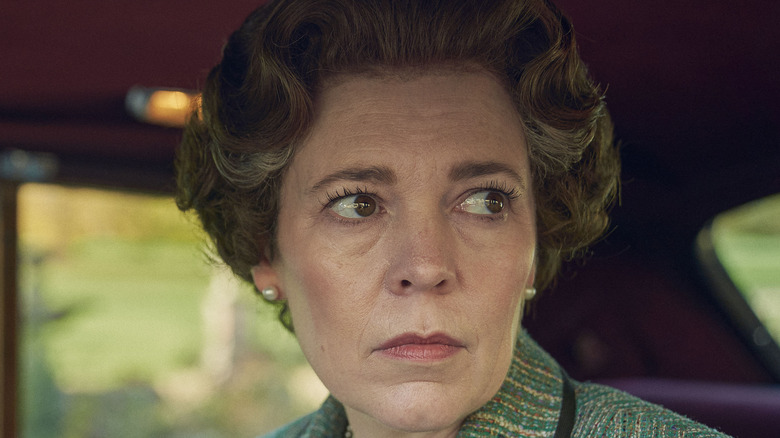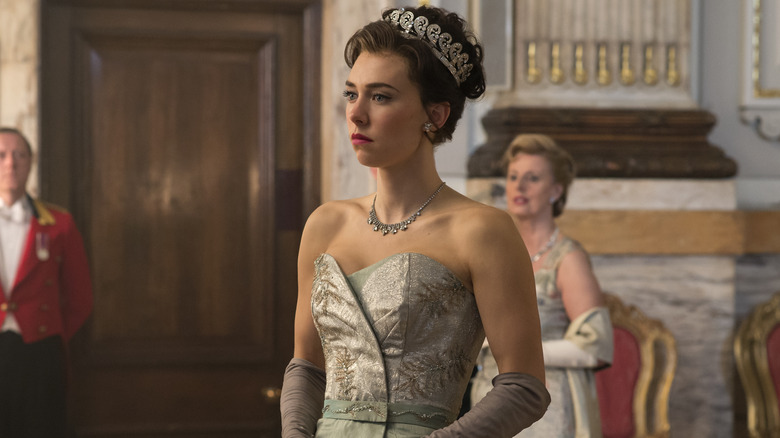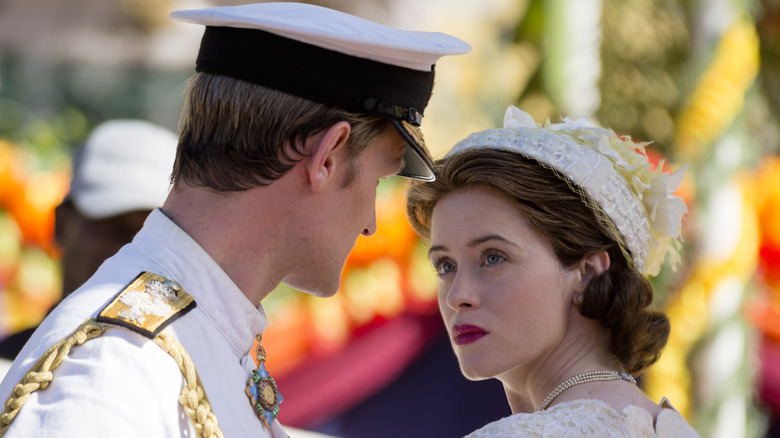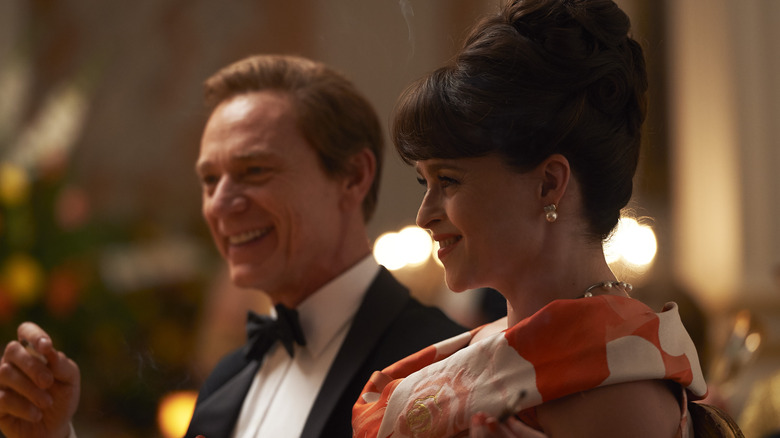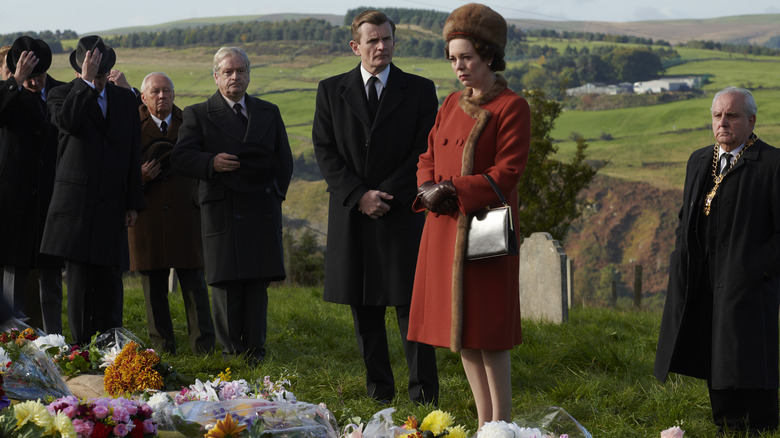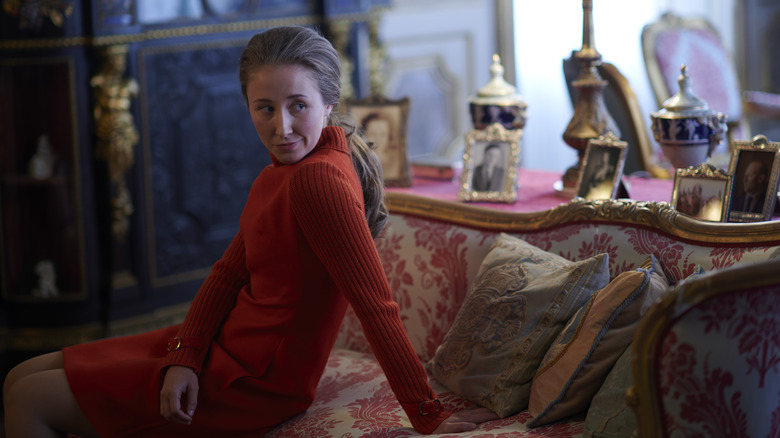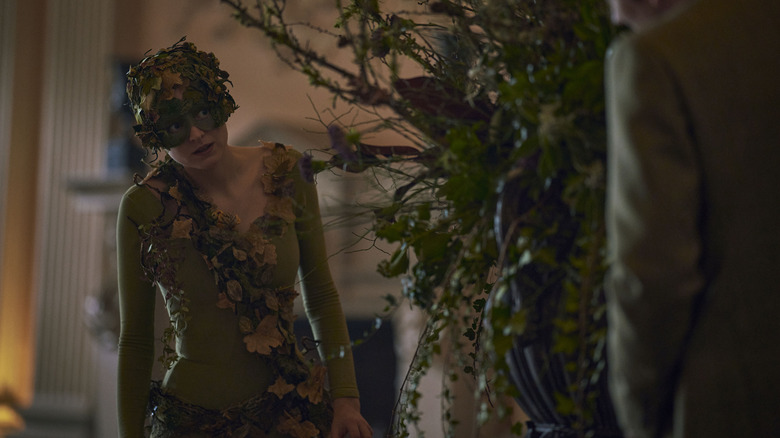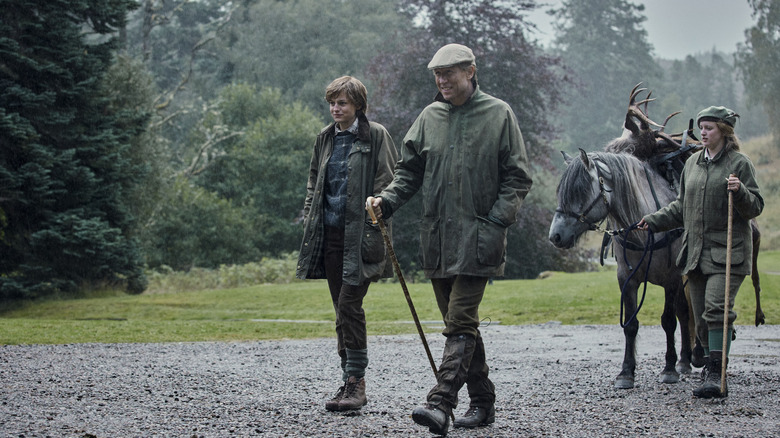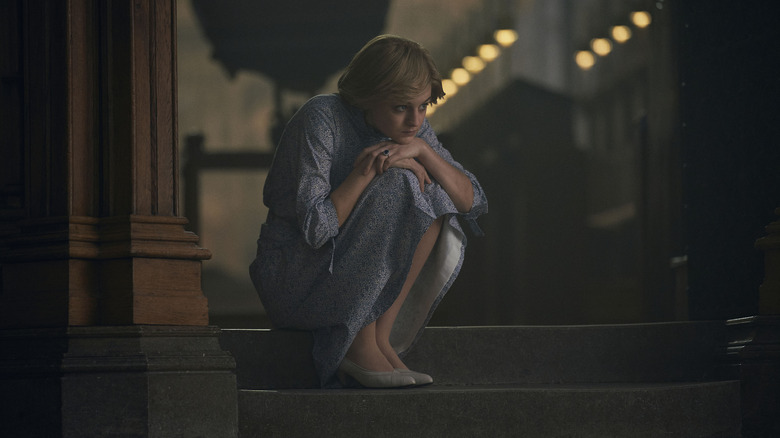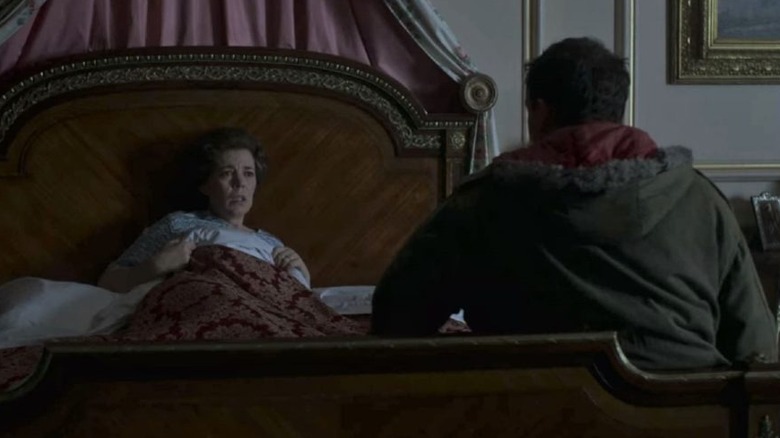Everything The Crown Gets Wrong About The True Story
The historical drama "The Crown" has been charming viewers since its beginning in 2016, taking us on the journey of the late Queen Elizabeth II. Created by Peter Morgan, "The Crown" chronicles the events of Queen Elizabeth's reign, from her coronation to her marriage, to scandal after scandal, and through an absurd number of Prime Ministers. It begins in 1947 and runs right through to the early 1990s, with the show still in progress. The 5th season debuting in November 2022 will cover the transition into the 21st century and the time leading up to the death of Princess Diana.
"The Crown" has covered a lot of ground, entertained us, and given us insight into a lifestyle that's hard to imagine. The series has been praised for its acting and writing. It's also proved very popular, with up to 21 million households watching Season 3 in its first four weeks. It surged back into the Netflix top 10 after the passing of Queen Elizabeth in September.
A series with this level of popularity is, of course, subject to criticism. For "The Crown," a show detailing a real-life Monarchy, the criticism lies in its accuracy. However, in a discussion with Town & Country magazine, the show's historical consultant Robert Lacey said, "Peter [Morgan] is very, very insistent, and so am I, that this is not a history documentary." Morgan and others, including Josh O'Connor (who portrays Charles in Seasons 3 and 4), have emphasized the fictional nature of the show. Still, it's interesting to dig below the surface and see exactly what "The Crown" omitted, dramatized, or made up altogether. Let's jump in.
Princess Margaret and Peter Townsend
The first two seasons starred Vanessa Kirby as a young Princess Margaret and detailed her struggle with her love life. She has a secret affair with Group Captain Peter Townsend, who used to work for her father. After Townsend's divorce, he and the Princess share their intention to marry. The reaction to the couple's plans is explosive because of Townsend's status as a divorced man, with the Queen shocked and parliament threatening the Princess with exile.
In the show, as head of church and state, the Queen must come to a decision. Initially, she wants to support Margaret and gives the Princess her word. However, she cannot keep her promise, which results in a heartbroken Margaret. It ends with the Queen putting the Crown before her family.
The real-life story behind this plot line went down quite differently. The Queen wanted her sister to marry Townsend and even drew up an agreement with the Prime Minister allowing Margaret to keep her titles and perform her duties, as documented in papers from The National Archive. The only thing she would have given up is her rights of succession and her future children's. If you do not quite believe it yet, the Queen's perspective was also detailed in a letter from Anthony Eden to the other leaders of the commonwealth: "Her Majesty would not wish to stand in the way of her sister's happiness." This greatly contrasts the slightly icy reaction from the Queen in "The Crown."
In both the show and reality, this saga ended with a twist: Princess Margaret decided not to marry Townsend, despite the agreement. An unexpected ending indeed.
Philip's ballerina
Another plot point for the earlier seasons is the Queen's relationship with Prince Philip (portrayed by Matt Smith). Of course, this comes with a scandal. In the drama series, Philip is shown as a laid-back partier and a member of an exclusive gentlemen's group called The Thursday Club. His insecurities around being second best to his wife encourage this particular lifestyle, with Philip often feeling ignored and overlooked. This all comes to a head when Queen Elizabeth finds a picture in Philip's belongings: a framed portrait of a ballerina. It takes until the end of Season 2 for her to confront Philip. Did this actually happen?
There is no solid evidence to prove Philip was ever actually unfaithful. However, he was apparently quite the ladies' man, according to Town & Country, with his name being linked to a number of famous women, such as the actress Pat Kirkwood. When questioned directly about his rumored cheating, Prince Philip was documented to have said: "Good God woman... Have you ever stopped to think that for years, I have never moved anywhere without a policeman accompanying me? So how the hell could I get away with anything like that?"
The Russian ballerina in "The Crown," Galina Ulanova, is a real person, but there is nothing to suggest she ever had any connection to the Duke of Edinburgh. She was much too busy with her ballet, and while she had a few husbands during her life, Ulanova ultimately ended up with a female companion who remained with her until her death.
President Johnson's meeting with Princess Margaret
Early in Season 3 of "The Crown," viewers see the relationship between the UK and USA falter, with President Lyndon B. Johnson appearing indifferent to royal matters and the special relationship between the countries. In the show, an older Queen Elizabeth (now portrayed by Olivia Colman) extends an invitation for the President to visit the palace, which goes ignored. Princess Margaret (now played by Helena Bonham-Carter) happens to be embarking on a long trip around the United States with her husband, Lord Snowdon. How convenient. The Queen arranges for Princess Margaret and her husband to join the President for dinner at the White House. This actually did happen.
In the show, the evening is portrayed as a rowdy affair full of swearing and inappropriate limericks. It marks the reunion of America and England, all thanks to the charms of Princess Margaret. While it has been documented as a very relaxed evening, we unfortunately do not have any proof that the amusing limerick competition occurred. The attendees did, however, dance a lot. According to a Vanity Fair article about that night, Princess Margaret and President Johnson danced together to "Everything's Coming Up Roses," all guests were completely at ease, and the party lasted into the wee hours of the morning. We'll never know the exact truth of this elusive evening, but being a fly on the wall will have been interesting indeed.
The Aberfan disaster
October 21, 1966, was a day of true tragedy. A landslide of coal waste fell onto the town of Aberfan in Wales and killed 116 children and 28 adults. Once a major mining location, it had since been neglected, which led to the preventable tragedy. This event is covered in Episode 3, Season 3 of "The Crown." Queen Elizabeth is unsure how to proceed, despite the Prime Minister's opinion that she should visit the scene of the tragedy. She is reluctant to go, waiting eight days before making an appearance.
When the Queen does visit, she feigns grief and sadness for the people of Aberfan — even mustering up a fake tear for the cameras. For viewers of "The Crown," she comes across as entirely detached from the tragedy. However, critics have claimed this part of the series is completely inaccurate. So, what's the truth?
In reality, the Queen views her delayed response to Aberfan as her "biggest regret." Her then-Private Secretary, Lord Charteris, shouldered some of the blame with his advice, commenting, "We told her to stay away [from Aberfan] until the preliminary shock had worn off." The Queen's emotional reactions when visiting the scene of the disaster might have been genuine, with witnesses and journalists stating that she was "visibly moved." Marilyn Brown, who lost her daughter to the tragedy, also commented on the Queen's presence: "You could see that she was quite emotional. You could see that she cared, you know." We can assume that her stoicism in the show was simply a tool to emphasize the situation.
Princess Anne and Andrew Parker-Bowles
Moving on to more matters of the heart, let's look at the affair that took place between Princess Anne (Erin Doherty) and Andrew Parker-Bowles. And yes, you're recognizing that surname correctly. "The Crown" suggests Princess Anne began a relationship with Andrew Parker-Bowles during his on-again, off-again relationship with his girlfriend Camilla. Of course, Prince Charles is thrown into the mix with his involvement with Camilla, with whom he ultimately fell in love — even during her marriage to Andrew Parker-Bowles. "The Crown" creator Peter Morgan puts these events very close to each other, overlapping and creating a complex crossover involving both Anne and Charles. It makes for a great storyline, but is it real?
The answer is yes and no. Yes, Princess Anne had a short relationship with Andrew Parker-Bowles. The union wasn't built to last; Parker-Bowles was Catholic, which meant Princess Anne couldn't marry him (the Royal Family is strict in its adherence to the Church of England). According to historian Sally Bedell Smith (via Town & Country), "Even when their romance eventually wound down, they remained lifelong friends."
The timing of the romances in "The Crown" was off, however. Smith does not believe that Princess Anne and Parker Bowles's relationship overlapped with Prince Charles and Camilla's. This is an understandable creative choice from creator Peter Morgan, and the love that viewers watched on "The Crown" was entertaining indeed, albeit not rooted in the entire truth.
Charles and Diana: the early years
Season 4 of "The Crown" brings viewers a long-awaited arrival: the beloved people's princess, Diana Spencer (Emma Corrin). We first meet her in Episode 1 as a 16-year-old who sneakily orchestrates a meeting with Prince Charles while dressed as a tree, for a school production of Shakespeare's "A Midsummer Night's Dream." It is whimsical, fairy-tale-like, and—you guessed it—not true. Well, not entirely. As shown in the series, Prince Charles was indeed dating Diana's older sister, Sarah, when the pair first met. Diana was 16 years old at the time, but not dressed as a tree at their first meeting, which occurred when Charles visited the Spencer estate for grouse hunting in November 1977. The romance between Diana and Charles began when Diana was 18 years old in 1980.
If the courtship between Prince Charles and Diana felt rushed to viewers of "The Crown," that makes sense; it was in real life, too. According to an article from Harper's Bazaar, the two of them only met publicly 13 times before getting engaged. Before the speedy engagement, Diana stayed at Balmoral with Prince Charles and the other Royals. In this drama-filled episode, which makes viewers fall in love with Diana, the visit is portrayed as a raging success for her. She charms and impresses by helping Prince Philip on a hunting trip and partaking in fun family party games. This works well for the TV show, but digging into the real story, we find out that Diana did not actually enjoy her time at the castle. In the documentary "Diana: In Her Own Words," the Princess said being there made her panicky, adding, "There are so many negative atmospheres. That house sucks one dry." Unfortunately for Diana, this was a sign of things to come.
The Balmoral Test
As mentioned briefly earlier, the Balmoral Test appears in Season 4, Episode 2 of "The Crown." In the episode, it is a vital initiation for outsiders who wish to spend time with the Royals. Visitors are invited to stay with the Royal family at Balmoral castle in Scotland, partaking in dinners, social events, and hunting, among other activities. In "The Crown," the first test victim is Prime Minister Margaret Thatcher (Gillian Anderson). The awkward, tense episode documents Thatcher making several mistakes, including dressing for dinner too early (shocker!) and struggling to get involved with the Royal party games. The general consensus is that Thatcher failed the test and was subject to slight rudeness from the Royals, leading to embarrassment and an eventual early exit.
The Balmoral Test is real, though members of the Royal family are unlikely to call it such. It is more likely a term used by outsiders for this potentially grueling initiation ceremony. Thatcher did indeed hate visiting Balmoral, which, as outlined in an article from The Guardian, she called "purgatory." As for the other visitor seen in "The Crown," Diana: meeting your boyfriend's parents is daunting enough, but when his mother is The Queen and you have to spend a whole weekend with her at a remote Scottish castle, that's downright terrifying. Was it as scary as it seems? We'll never quite know. However, in an article from Bazaar, Royal Editor Omid Scobie said: "despite all the talk of it being a 'test,' the Queen is also at her most laid back during summers at Balmoral. Her Majesty will always goes out of her way to make every guest feel welcome and at home."
Princess Diana's mental health
Diana's mental health is depicted in "The Crown" as a major plot point for the Princess, affecting her greatly throughout her time in the Royal family. We see her struggling with depression and loneliness. One of the most heartbreaking parts of Season 4 is watching Diana and her suffering and her need for love and connection. We become invested in the story of a young woman who fell in love with a Prince without realizing her Prince was already in love with someone else. Screenwriter Peter Morgan also emphasizes Diana's eating disorder beginning in Episode 3. It's shown as a form of emotional release for the Princess-to-be.
"The Crown" omits certain details, such as what Princess Diana claimed triggered her bulimia. In a National Geographic documentary, Diana said that Prince Charles "put his hand on my waistline and said: 'Oh, a bit chubby here, aren't we?'" Furthermore, Peter Morgan did not include Diana's suicide attempts as outlined in the Andrew Morton book "Diana: Her True Story in Her Own Words." This biography says that Princess Diana attempted suicide multiple times, including while she was pregnant. Morgan may have felt that the eating disorder communicated her struggles enough, but it is important to be aware of how much Diana went through.
If you are struggling with an eating disorder, or know someone who is, help is available. Visit the National Eating Disorders Association website or contact NEDA's Live Helpline at 1-800-931-2237. You can also receive 24/7 Crisis Support via text (send NEDA to 741-741).
The Buckingham Palace intruder
Season 4, Episode 5 of "The Crown" focuses on a non-Royal. We are introduced to local Michael Fagan, a down-on-his-luck man who's separating from his wife and losing custody of his children. He's also been hit hard by Britain's economic crisis and is struggling to get work to pay the bills. Fagan is angry at the government in general and Margaret Thatcher in particular. This leads him to make an odd decision: he breaks into Buckingham Palace not once, but twice. The first time, he steals a bottle of wine; the second, he breaks into the Queen's bed chambers. A scared Queen Elizabeth attempts to call for help, but is silenced by Fagan, who just wants to talk to her. He tells her about his problems regarding the political and economical climate of the UK in an attempt to motivate her to make changes. He is then taken away by security. It makes for an excellent episode to frame the unemployment problem that was rampant in the UK at the time.
However, the reality is a little less poignant. Michael Fagan did indeed illegally enter the palace on two separate occasions. According to The Independent, on the first visit, he "tried out several of the thrones and ultimately decided to leave after no one came to find him." Ultimately, Fagan's reasoning for the break-ins was not overtly political. On the second visit, he met the Queen in her bedroom. News reports at the time said The Queen spoke to him at length, stalling until her guards arrived, but Fagan disputes this, saying their encounter was brief, so "The Crown" may not be accurate in this regard. Further into the interview with The Independent, Fagan comments, "I don't know why I did it, something just got into my head." He also placed some blame on taking too many magic mushrooms a few months prior and still feeling the effects, a detail "The Crown" does not include.
